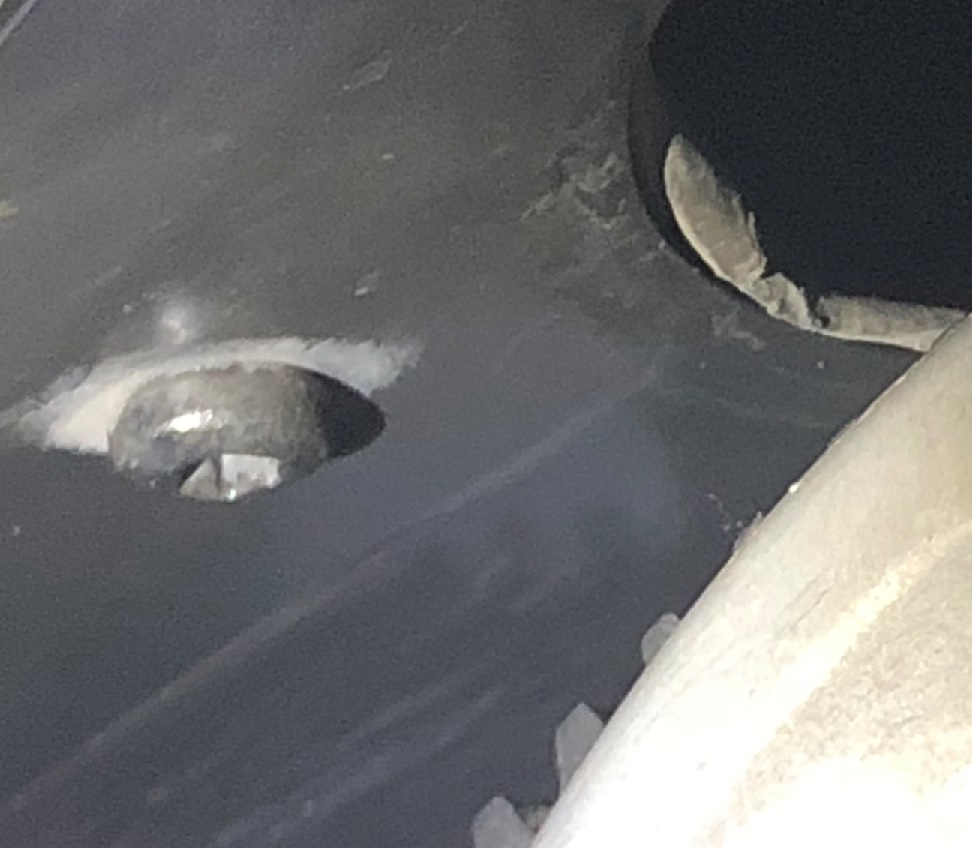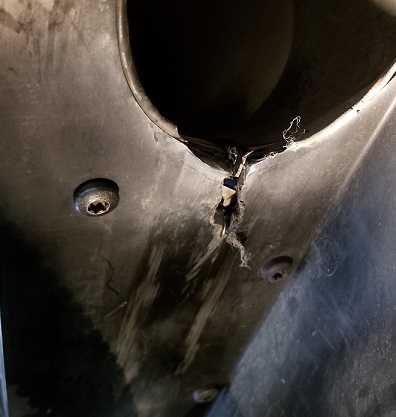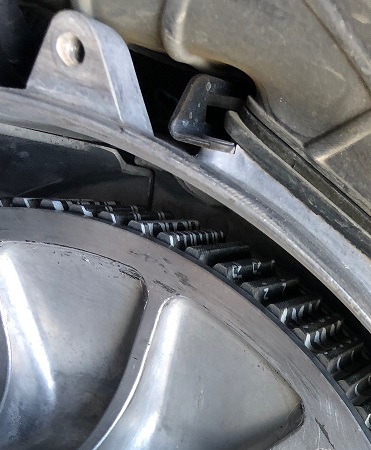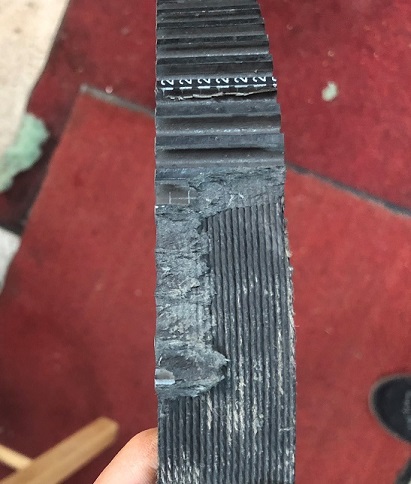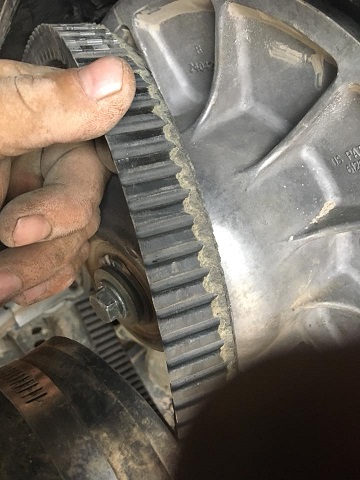Top Cogs Missing on CVT Belts Before we get started the sky is not falling so no one panic about this, this is just information that does affect a number of people, the following conditions etc does not automatically apply to everyone and "always" cause "everyone" trouble. If it applies to you then it does. This week, I have received four emails and or calls about top cogs coming off, three were 16 and newer non turbo vehicles, two XP 1000 and one General and one was a turbo RZR. The belts on them were two OEM belts and two were Hunterworks. Top cogs missing or ripped off is rather common, and it almost always means the belt hit something, normally the exhaust duct, look at the two pics below, if you look close to the one you can see the leading edge of the duct is no longer sharp and there is a line ahead of it where the belt hit, the second picture is a bad one that hit hard. The third is a turbo RZR and just showing you what a belt can hit.
What is the cause? This is the tricky part, can be multiple things, some you can fix and some you can't. The part you can't fix is just a random set of conditions that you put your vehicle in and most likely in a rapid deceleration like a jump, going over a dune etc. When you rapidly decel the clutches can't react fast enough and there is slack in the belt and your tires are turning the transmission shaft now, the secondary clutch becomes the drive clutch on decel. This happened to yours truly, wrong belt using our thick belt, put a engine braking helix in my XP and did a huge jump, landed in engine braking mode and the excess shot to the top and ripped the belt to shreds, put another belt on, this time our STD belt and stayed off the big jumps and no more issues. That is an example of a one time event. However your one time event does not have to be as violent as mine to make this happen. Big tires accentuate engine braking due to increasing the gear ratio so on decel they are turning the tranny shaft faster than smaller tires therefore the belt is trying to turn the motor backwards harder. Too much to type to fully explain this, just know big tire increase engine braking. If you are going to be a jumper, get a non ebs helix and might want to consider smaller tires. Cross country racers use small tires most of the time. What physical issues that are fixable could cause this? In all models except turbos that have either the square pucks like the 16-19 models or even older models with round rollers can have bad pucks or flat rollers. The newer vehicles have square pucks, they wear the secondary clutch and then it does not want to operate as efficiently as it can, won't open or close fast enough sometimes and cause belt slack then that slack hits something. Older machines with round that go flat can cause the same thing. Just a FYI, we have round rollers to replace the square pucks and have better rollers that won't go flat like the OEM to stop this problem. Now the surface either run on, needs to be smooth. You can see those items on this page https://www.hunterworks.com/polaris_xp_1000_1000s The next physical issue that can cause this and this also happened to yours truly is shaft spacing gets off between the engine and transmission and the two shafts are too close together. With just 300 miles on my XP 1000 mine was off an 1/16" of am inch and that is like elongating a belt by 1/8" and I promise you that is enough to cause a problem. For me, I am not 100% if mine came from Polaris this way or I did it on the big jump, either way mine was off. We see a lot of the shaft spacing issues and sell a lot of the tools to check and fix it. https://www.hunterworks.com/inc/sdetail/56301/72670 Here is a couple examples of belts that were mild to bad!!!
So what do we do when it occurs? You need to look to see where it hit, most likely the top. Do you have flat spotted secondary rollers or square pucks? If you do, you fix them, put a new belt on and go again. Do you simply have higher miles on your machine and clutches so they just don't operate as efficiently as they once did? Do you have larger than OEM tires and recently did some aggressive riding that could have created a one time event to cause this? All the above issues, happen on almost all of the Polaris vehicles and the only belt that I know of that is the wrong dimension is the Gates 27c4159 but it is too short, it causes inside teeth to come out not top cogs. So my point is, it is not your belts no matter what brand you have and this condition happens them all. While on belts, as the maker now of belts on the few we had to warranty, the one comment I hear is, I got X amount of miles and only X amount on this one. I have been hearing that as long as we been selling belts, Gates for four or five years and our own now. Most times the second and third belt and so on will never last as long as the first, you had two new clutches and spacing and alignment was right. If you want to use that argument, then buy two new clutches and an alignment tool then make the argument. New brake pads do not last as long as first set if you put them on old rotors!!! Hunterworks being pro-active!!! What we did and I want you to read this closely is, we made a recent change in our belts. The closely part is, we didn't make a change because we were having an problem, we made a change because you were having a problem and we wanted to be proactive about it. Being proactive and making your own belts, you can make changes as needed. Anyway, so since we know that spacing gets off, we know the deal with secondary rollers and pucks and we know one time events happen so we made a change. All our Polaris belts now have a shorter top cog on them and we changed the binding agent which is basically the glue that holds the top layer on, to something that holds better. What this does is give you a slight bit more clearance to keep the belt from hitting and in the event of it still hitting make it potentially more durable in two ways. The shorter cog will not have the leverage a taller one would have when it hits and the binding agent holds it better too. No other belt maker has taken this proactive approach to help you out. The blunt part: We have been shipping the new belt out for about three weeks now today is 11/1/2018, if you have a "older" one we can't take it back and exchange it as we could not sell an "older" style now. Don't freak out, remember nothing wrong with them that is not wrong with any other, it is not the belt. The new one just addresses this condition is all. Everything mentioned above is still a small number of people compared to the masses and this is just information to help you out. In the even any of this is occuring to you, we are here with parts, belts, tools and free advice to help you out so you can stop having this or any other clutching issue, that is what we do if you will let us help you. Thanks, Todd |
|


































































































